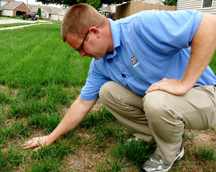Purdue Extension has advice for repairing drought-damaged lawns
September 19, 2012
 |
|
Purdue Extension turf grass
specialist Aaron Patton places his hand on a bare spot of a drought-damaged
lawn. He says if the damaged area is larger than the size of the hand print,
then it most likely needs to be reseeded. (Purdue Agricultural Communication
photo/Keith Robinson) |
WEST LAFAYETTE, Ind. - Many homeowners with drought-damaged lawns have some decisions to make about how to repair them now that it's the season. A Purdue turf grass Extension specialist says it mostly comes down to answering this question: Do I reseed, or will fertilizing be enough to recover my lawn?
First, the problem:
Most grass species in Indiana are "cool-season grasses," said Aaron Patton, who also is an assistant professor of agronomy. "They like cooler weather with adequate water."
That's not what lawns got this summer, when rain was scarce and temperatures were often in the 90s - even soaring above 100 degrees. Many lawns sustained damage or died from the heat and dry conditions.
Patton and Cale Bigelow, an associate professor of agronomy who specializes in turf grass science and management, offer guidance to homeowners on the website Purdue Turf Tips.
Some of their advice:
* Seed or fertilize? It depends on the size of the damaged area. Patton advises that if an area between clumps of surviving grass is larger than your hand print, then it probably needs to be reseeded.
Damaged areas that are smaller could be treated with fertilizer to encourage growth and recovery. When buying fertilizer, look on the label for a high percentage of nitrogen content. "That's the nutrient that helps plants grow the most," Patton said.
*Seeding: Types of seed to buy will depend on whether the area is sunny, shady or a mix of both.
Fine fescues, such as creeping fescue, are good for shady areas. Kentucky bluegrass or tall fescue are ideal for lawns with full sun. "Tall fescue has gained popularity over the last few years in that it keeps its green color longer during drought," Patton said. A mix of tall fescue and Kentucky bluegrass works well in areas of high traffic.
Patton advised against buying products stating that the seed establishes itself quickly. Such seeds typically have a lot of annual ryegrass, which is not cold-hardy or tolerant of heat and drought.
"It is not a long-term species for your lawn," he said. "Just be real careful when you're buying seed to make sure you get the right turf species."
* Site preparation for seeding: Remove debris and patches of dead grass with a garden rake to ensure that the new seed contacts the soil.
"If we can get the seed down to that area, it will have a much better chance of getting established," Patton said.
In addition, aeration is a good way to prepare lawns for seeding, and you also get the added benefits of reducing soil compaction and improving rooting and water infiltration.
* Starter fertilizers: Such fertilizers are high in phosphorus - good for new lawns established from seed. "It helps a newly seeded lawn to develop its root system and grow strong," Patton said.
* Herbicides: They can damage seedlings if applied too soon after seeding. Patton advises reading the product instructions to determine how soon you can apply after seeding, often after cutting the new grass three times.
A video describing repairing lawns is available at http://www.youtube.com/watch?v=hXZMfCVW0os&feature=youtu.be
More information on lawn care and the drought are available at http://www.purdue.edu/drought and http://www.the-education-store.com
Writer: Keith Robinson, 765-494-2722, robins89@purdue.edu
Source: Aaron Patton, 765-494-9737, ajpatton@purdue.edu
Note to online editors: A link to a video clip of Purdue turf grass Extension specialist Aaron Patton giving advice on how to repair lawns damaged by the drought is at the bottom of this news release. The video can be embedded in your website.
VIDEO:
A
link to a video describing repairing lawns is available at
http://www.youtube.com/watch?v=hXZMfCVW0os&feature=youtu.be
EMBED:
<iframe
width="560" height="315"
src="http://www.youtube.com/embed/hXZMfCVW0os"
frameborder="0" allowfullscreen></iframe>
Ag Communications: (765) 494-2722;
Keith Robinson, robins89@purdue.edu
Agriculture News Page

